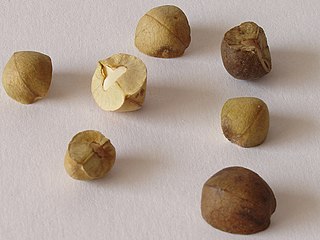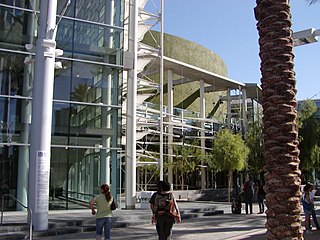Related Research Articles

Tucson is a city in and the county seat of Pima County, Arizona, United States, and is home to the University of Arizona. It is the second largest city in Arizona behind Phoenix, with a population of 542,629 in the 2020 United States Census, while the population of the entire Tucson metropolitan statistical area (MSA) is 1,043,433. The Tucson MSA forms part of the larger Tucson-Nogales combined statistical area (CSA). Both Tucson and Phoenix anchor the Arizona Sun Corridor. The city is 108 miles (174 km) southeast of Phoenix and 60 mi (97 km) north of the U.S.–Mexico border. Tucson is the 33rd largest city and the 58th largest metropolitan area in the United States (2014).

Entomology is the scientific study of insects, a branch of zoology. In the past the term "insect" was less specific, and historically the definition of entomology would also include the study of animals in other arthropod groups, such as arachnids, myriapods, and crustaceans. This wider meaning may still be encountered in informal use.
The Arizona-Sonora Desert Museum is a 98-acre zoo, aquarium, botanical garden, natural history museum, publisher, and art gallery founded in 1952. Located just west of Tucson, Arizona, it features two miles (3.2 km) of walking paths traversing 21 acres of desert landscape. It is one of the most visited attractions in Southern Arizona.

The Southwestern United States, also known as the American Southwest or simply the Southwest, is a geographic and cultural region of the United States that generally includes Arizona, New Mexico, and adjacent portions of California, Colorado, Nevada, Oklahoma, Texas, and Utah. The largest cities by metropolitan area are Phoenix, Las Vegas, El Paso, Albuquerque, and Tucson. Prior to 1848, in the historical region of Santa Fe de Nuevo México as well as parts of Alta California and Coahuila y Tejas, settlement was almost non-existent outside of Nuevo México's Pueblos and Spanish or Mexican municipalities. Much of the area had been a part of New Spain and Mexico until the United States acquired the area through the Treaty of Guadalupe Hidalgo in 1848 and the smaller Gadsden Purchase in 1854.

The Sonoran Desert is a North American desert and ecoregion that covers large parts of the southwestern United States, as well as the northwestern Mexican states of Sonora, Baja California, and Baja California Sur. It is the hottest desert in both Mexico and the United States. It has an area of 260,000 square kilometers (100,000 sq mi).

Mexican jumping beans are seed pods that have been inhabited by the larva of a small moth and are native to Mexico. The "bean" is usually tan to brown. They are from the shrub Sebastiania pavoniana, often also referred to as "jumping bean". However, they are not related to actual beans, but rather to spurges. The beans are considered non-toxic but are not generally eaten. In the spring, when the shrub is flowering, moths lay their eggs on the shrub’s hanging seedpods. When the eggs hatch, tiny larvae bore into the immature green pods and begin to devour the seeds. The pods ripen, fall to the ground and separate into three smaller segments, and those segments are what we call Mexican jumping beans. As the tiny larvae inside curl up and uncurl, they hit the capsule’s wall with their heads – and the bean jumps. It’s been observed that they move more as temperatures rise, the larva eats away the inside of the bean and attaches itself to the inside of the bean with silk-like thread. The larva may live for months inside the bean with varying periods of dormancy. If the larva has adequate conditions of moisture and temperature, it will live long enough to go into a pupal stage. In the spring, the moth forces itself out of the bean through a round "trap door", leaving behind the pupal casing. After its metamorphosis, the small, silver and gray-colored moth lives for no more than a few days.

The Tucson Botanical Gardens is a 5.5 acre collection of sixteen residentially scaled urban gardens in Tucson, Arizona, United States. Paths connect these gardens, which include a Zen Garden, a Prehistoric Garden, a Barrio Garden, a Butterfly Garden, a Xeriscape Garden, and a Children’s Garden.
Banner - University Medical Center Tucson (BUMCT), formerly University Medical Center and the University of Arizona Medical Center, is a private, non-profit, 649-bed acute-care teaching hospital located on the campus of the University of Arizona in Tucson, Arizona. BUMCT is part of the University of Arizona Health Sciences (UAHS) center campus which includes the university's Colleges of Medicine, Nursing, Pharmacy and Public Health. It is Southern Arizona's only trauma center for both adult and pediatric patients. BUMCT is one of two University of Arizona affiliated academic medical centers in Tucson with Banner - University Medical Center South being the other such institution. The area's only dedicated children's hospital, Banner Children's at Diamond Children's Medical Center, is located within and adjacent to BUMCT, providing care to infants, children, teens, and young adults aged 0–21.

The Mesa Arts Center is a performing and visual arts complex in downtown Mesa, Arizona. At more than 210,000 square feet (20,000 m2) square feet, the $95 million facility, completed in 2005, is the largest comprehensive arts campus in the state.
The University of Arizona College of Medicine – Tucson, located in Tucson, Arizona, is one of three MD granting medical schools in the state of Arizona, affiliated with the University of Arizona. The University of Arizona College of Medicine – Phoenix was initially established as a branch campus in 2007, but became an independent medical school in 2012. The College of Medicine – Tucson campus is located at the University of Arizona Health Sciences (UAHS) center on the campus of the University of Arizona and is governed by the Arizona Board of Regents. Traditionally, the college accepted Arizona residents exclusively. However, beginning the 2009–2010 incoming class, the school changed its policy to allow for admission of "highly-qualified," non-residents.
SASI may refer to:
An insectarium is a live insect zoo, or a museum or exhibit of live insects. Insectariums often display a variety of insects and similar arthropods, such as spiders, beetles, cockroaches, ants, bees, millipedes, centipedes, crickets, grasshoppers, stick insects, scorpions, mantids and woodlice. Displays can focus on learning about insects, types of insects, their habitats, why they are important, and the work of entomologists, arachnologists, and other scientists that study terrestrial arthropods and similar animals.

Arthropodology is a biological discipline concerned with the study of arthropods, a phylum of animals that include the insects, arachnids, crustaceans and others that are characterized by the possession of jointed limbs.

Phoradendron californicum, the desert mistletoe or mesquite mistletoe, is a hemiparasitic plant native to southern California, Nevada, Arizona, Sonora, Sinaloa and Baja California. It can be found in the Mojave and Sonoran Deserts at elevations of up to 1400 m.

The Arizona Sun Corridor, shortened Sun Corridor, is a megaregion, or megapolitan area, in the southern area of the U.S. state of Arizona. The Sun Corridor is comparable to Indiana in both size and population. It is one of the fastest growing conurbations in the country and is speculated to double its population by 2040. The largest metropolitan areas are the Phoenix metropolitan area – Valley of the Sun, and the Tucson metropolitan area – The Old Pueblo. The regions' populace is nestled in the valley of a desert environment. Similar to Southern California, the urban area extends into Mexico, reaching the communities of Nogales and Agua Prieta.
David Albert Yetman is an American academic expert on Sonora, Mexico and an Emmy award-winning media presenter on the world's deserts. He is a research social scientist at the University of Arizona.
The Colibrí Center for Human Rights is a non-profit non-governmental organization that uses forensic anthropology and advocacy to identify lives lost on the United States-Mexico border and to help families find loved ones who have gone missing on the border. Their director Robin Reineke won a Letelier-Moffitt Human Rights Award in 2014.

The Tucson Arizona Temple is a temple of The Church of Jesus Christ of Latter-day Saints in Catalina Foothills, Arizona, just north of Tucson. The intent to construct the temple was announced by church president Thomas S. Monson on October 6, 2012, during the church's semi-annual general conference. The temple is 38,216 square feet (3,550.4 m2) and is located on a 7.4-acre (3.0 ha) site.

UNESCO's City of Gastronomy project is part of the wider Creative Cities Network. The Network was launched in 2004, and organizes member cities into seven creative fields: Crafts and Folk Art, Design, Film, Gastronomy, Literature, Media Arts, and Music.

Hostile Terrain 94 (HT94) is a participatory art project created and organized by the Undocumented Migration Project (UMP). The exhibition is composed of approximately 3,400 handwritten toe tags that represent migrants who have died trying to cross the Sonoran Desert of Arizona between the mid-1990s and 2021. The tags are geolocated on a large wall map of the Arizona/Mexico border, showing the exact locations where human remains were found. This DIY installation is taking place at over 120 institutions––in the U.S. and abroad––with the intention to raise awareness about the humanitarian crisis at America's southern border and to engage with communities around the world in conversations about migration.
References
- ↑ Pima County Attractions – Sonoran Arthropod Studies Institute http://www.pimacountyattractions.com/attrac.html#anchor219785
- ↑ Arizona Insects – Sonoran Arthropod Studies Institute http://www.arizonainsects.com/Articles.php?action=detail&g=content1190674796&pid=652
- ↑ Sonoran Arthropod Studies Institute – About SASI http://www.sasionline.org/
- ↑ International Association of Butterfly Exhibitors and Suppliers – Why Visit A Butterfly House? "Why Visit a Butterfly House?". Archived from the original on 2010-06-13. Retrieved 2010-05-17.
- ↑ SASI – Medical Entomology Today!